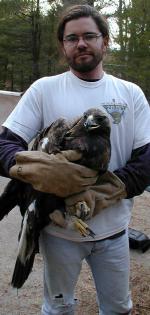|
Bald Eagle Migration Update: March 3, 2004 Today's Report Includes:
Slow Week
Here's the Latest Data and Migration Map
Hello Students
and Eagle Lovers! In looking at this past week's data, do you think our eagles are showing any signs of spring fever? From what I can see of the data, they are all still sticking pretty close to their usual winter haunts. But, weather patterns and hormones are definitely changing this time of year, and it won't be long until we see some movements. Look back at last years data and see when these three eagles departed last year. It is always fun to see how close the departure dates are from one year to the next, and to hypothesize why changes/differences might occur. Meanwhile,
we are still attempting to capture a wintering eagle or two before the
season comes to an end. As I explained in an initial message, one of
our team, Scott VanArsdale, has been trying hard to capture the mate
of golden eagle A00, whom he captured last year. I am trying to get
a head start on a major study of bald eagles of our Delaware River we
are launching next year, by trying to get a bird down there yet this
winter. I will be in the field tomorrow with other team members Kathy
Michell and Steve Lawrence giving it one more try. I hope I may have
a good story for you next week! Until then, keep alert and keep studying! Eagleye
Nye Try This! Do Eagles Migrate at the Same Time Each Year? Take a look at migration records from past springs and predict when the eagles will take off this year. Peter Nye is doing the same thing right now! Below are the dates when eagle E50 began migrating north (meaning the first jump north that occurred by this date) in spring 2002 and 2003.
These dates are spaced quite a bit apart. What do you suppose would have caused this bird to wait until mid-April in 2003? Peter Nye says that often birds who wait late into spring will migrate a great distance into the North. Do you think E50 was going to go far, far into the North country in 2003? Now, what about eagles A00 and A20? Use the Journey North archives to find out when the 2 Golden eagles started their migrations.
(To respond to this question, please follow the instructions below.) Lead in Our Environment: Discussion of CQ #6 How does lead get into the bodies of wild animals and what can we do to help prevent lead-poisoning? Once again your answers show you have done your homework!
Find out more. Read how lead gets into animals, what happens to a bird with lead poisoning, how it is treated, and - most importantly - what we can do to help clean up our environment.
Teacher Tip: Reading and Writing Connection for Get the Lead Out Talons vs. Beaks: Discussion of CQ #7
Here are just a few of the reasons that students listed. Great scientific thinking!
Thanks to Park Rapids 5th Graders, Armenian Sister's Academy, Luke Amber, Iselin Middle Schoolers, and Ferrisburgh Central School! Read on to hear what Journey North bird expert, Laura Erickson has to say about this. Adaptation: Talons - Discussion CQ #8
What makes talons different from claws? Park Rapids, MN, 5th Graders used a Venn diagram to show the relationship between claws and talons. They told us, "Talons are a very special kind of claw, but claws are not a special type of talon. So, all talons are claws, but not all claws are talons." Other differences you wrote:
Eagle talons
are among the largest, strongest in the bird world. But their feet aren't
quite as well designed for capturing fish as osprey feet are. Bald Eagle Adaptations: The Beak and Head
Are you ready for this week's adaptation? The eagle's whole head is designed for its fishing and scavenging lifestyle. Take a close look at their head and decide why it has adapted uniquely for this powerful animal.
(To respond to this question, please follow the instructions below.) Ask the Bald Eagle Expert - Open Until March 5 Do you have a question you want to ask Peter Nye? Remember, the deadline is Noon Central (or 1 pm Eastern time) on March 5, 2004. If you have trouble, please contact the Journey North office: our feedback form Answers from the Bald Eagle Expert will be posted on March 19, 2004 via e-mail and on the Journey North Web site. How to Respond to Today's Challenge Questions:
1. Address
an e-mail message to: jn-challenge-eagle@learner.org Copyright
1997-2004 Journey North. All Rights Reserved. |













